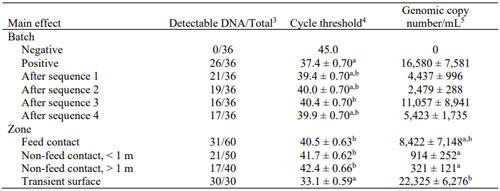Viral Transmission Through Feed
The ability of African Swine Fever Virus (ASFV) to move easily throughout a country due to movement of animals and contaminated fomites showcases the ability of ASFV to cause disastrous consequences on a naïve pig population. An introduction of ASFV into North America is a significant threat not only to the health and wellbeing of the swine population, but also to our significant trade relationships with countries that have endemic ASFV. Regulatory control of live animals and pork-containing foods substantially reduces this risk ASFV introductory into North America. However, because ASFV can survive in feed during shipping, there is concern that contaminated feed or ingredients will introduce ASFV into the North American swine population. Regardless of its method of entry, there is concern that infection of US or Canadian pigs may result in contamination of the feed supply chain, leading to rapid and widespread distribution of the virus like what was seen with Porcine Epidemic Diarrhea Virus (PEDV). Field evidence suggests that ASFV can be distributed throughout the feed supply chain. Recent research confirmed that the distribution of ASFV into the feed manufacturing environment is widespread and persists even after manufacturing additional feed batches initially free of ASFV. This is similar to what is observed with PEDV and indicates that it is extremely important to prevent the entry of ASFV into feed mills. Therefore, reducing the risk of ASFV or other biological hazards in feed manufacturing facilities is an important part of the complete biosecurity plan for pig producers.
Key words: feed mill biosecurity, viral transmission.
Introduction
Distribution of African Swine Fever Virus Into the Feed Manufacturing Environment

Strategies to Reduce Risk of Viral Transmission Through Feed
Ingredient Sourcing
Receiving and Loadout Practices
Zones in the Mill
Feed Handling
Employee Training
Culture
Conclusion
Bellini, S., D. Rutili, & V. Guberti. 2016. Preventive measures aimed at minimizing the risk of African swine fever virus spread in pig farming systems. Acta Veterinaria Scandinavica, 58, 82. https://doi.org/10.1186/s13028-016-0264-x
Dee, S.A., F.V. Bauermann, M.C. Niederwerder, A. Singrey, T. Clement, M. de Lima, C. Long, G. Patterson, M.A. Sheahan, A.M.M. Stoian, V. Petrovan, C.K. Jones, J. De Jong, G.D. Spronk, L. Minion, J. Christopher-Hennings, J.J. Zimmerman, R.R.R. Rowland, E. Nelson, P. Sundberg, D.G. Diel. 2018. Survival of viral pathogens in animal feed ingredients under transboundary shipping models, PLoS One, 13, e0194509. https://doi.org/10.1371/journal.pone.0194509
Elijah, C.G., J.D. Trujillo, C.K. Jones, N.N. Gaudreault, C.R. Stark, K.R. Cool, C.B. Paulk, T. Kwon, J.C. Woodworth, I. Morozov, C. Gallardo, J.T. Gebhardt, and J.A. Richt. 2021. Evaluating the distribution of African swine fever virus within a feed mill environment following manufacture of inoculated feed. PLoS ONE, 12, e0187309. https://doi.org/10.1371/journal.pone.0256138
Gebhardt, J.T., S.S. Dritz, C.G. Elijah, C.K. Jones, C.B. Paulk, and J.C. Woodworth. 2021. Sampling and detection of African swine fever virus within a feed manufacturing and swine production system. Transboundary and Emerging Diseases, 69, 103-114. https://doi.org/10.1111/tbed.14335
Greiner, L.L. 2016. Evaluation of the likelihood of detection of porcine epidemic diarrhea virus or porcine deltacoronavirus ribonucleic acid in areas within feed mills. Journal of Swine Health and Production, 24, 198– 204.
Guinat, C., A. Gogin,S. Blome, G. Keil, R. Pollin, D.U. Pfeiffer, and L. Dixon. 2016. Transmission routes of African swine fever virus to domestic pigs: Current knowledge and future research directions. Veterinary Record, 178, 262– 267. https://doi.org/10.1136/vr.103593
Niederwerder, M.C., A. Stoian, R. Rowland, S.S. Dritz, V. Petrovan, L.A. Constance, J.T. Gebhardt, M. Olcha, C.K. Jones, J.C. Woodworth, Y. Fang, J. Liang, T.J. Hefley. 2019. Infectious Dose of African Swine Fever Virus When Consumed Naturally in Liquid or Feed. Emerging Infectious Diseases, 25(5), 891-897. https://doi.org/10.3201/eid2505.181495.
Olesen, A. S., G.J. Belsham, T. Bruun Rasmussen, L. Lohse, R. Bødker, T. Halasa, A. Boklund, and A. Bøtner. 2020. Potential routes for indirect transmission of African swine fever into domestic pig herds. Transboundary and Emerging Diseases, 67, 1472– 1484. https://doi.org/10.1111/tbed.13538
Schumacher, L. L., A.R. Huss, R.A. Cochrane, C.R. Stark, J.C. Woodworth, J. Bai, E.G. Poulsen, Q. Chen, R.G. Main, J. Zhang, P.C. Gauger, A. Ramirez, R.J. Derscheid, D.M. Magstadt, S.S. Dritz, & C.K. Jones. 2017. Characterizing the rapid spread of porcine epidemic diarrhea virus (PEDV) through an animal food manufacturing facility. PLoS ONE, 12, e0187309. https://doi.org/10.1371/journal.pone.0187309








